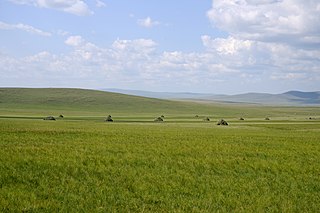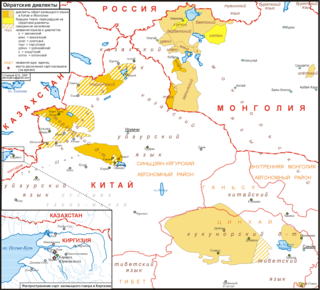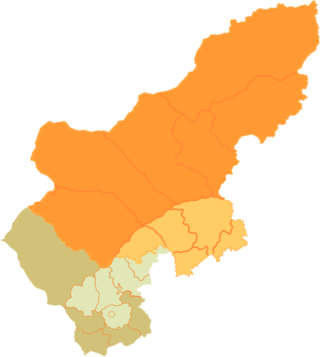Related Research Articles

Inner Mongolia, officially the Inner Mongolia Autonomous Region, is an autonomous region of the People's Republic of China. Its border includes two-thirds of the length of China's border with the country of Mongolia. Inner Mongolia also accounts for a small section of China's border with Russia. Its capital is Hohhot; other major cities include Baotou, Chifeng, Tongliao, and Ordos.

Mongolian is the principal language of the Mongolic language family that originated in the Mongolian Plateau. It is spoken by ethnic Mongols and other closely related Mongolic peoples who are native to modern Mongolia and surrounding parts of East and North Asia. Mongolian is the official language of Mongolia and Inner Mongolia and a recognized language of Xinjiang and Qinghai.

The Mongolic languages are a language family spoken by the Mongolic peoples in Eastern Europe, Central Asia, North Asia and East Asia, mostly in Mongolia and surrounding areas and in Kalmykia and Buryatia. The best-known member of this language family, Mongolian, is the primary language of most of the residents of Mongolia and the Mongol residents of Inner Mongolia, with an estimated 5.7+ million speakers.

Tuvan or Tyvan is a Turkic language spoken in the Republic of Tuva in South Central Siberia, Russia. The language has borrowed a great number of roots from the Mongolian language, Tibetan and the Russian languages. There are small diaspora groups of Tuvan people that speak distinct dialects of Tuvan in China and Mongolia.

Buryat or Buriat, known in foreign sources as the Bargu-Buryat dialect of Mongolian, and in pre-1956 Soviet sources as Buryat-Mongolian, is a variety of the Mongolic languages spoken by the Buryats and Bargas that is classified either as a language or major dialect group of Mongolian.

Oirat is a Mongolic language spoken by the descendants of Oirat Mongols, now forming parts of Mongols in China, Kalmyks in Russia and Mongolians. Largely mutually intelligible to other core Central Mongolic languages, scholars differ as to whether they regard Oirat as a distinct language or a major dialect of the Mongolian language. Oirat-speaking areas are scattered across the far west of Mongolia, the northwest of China and Russia's Caspian coast, where its major variety is Kalmyk. In China, it is spoken mainly in Xinjiang, but also among the Deed Mongol of Qinghai and Subei County in Gansu.
The Khalkha dialect is a dialect of central Mongolic widely spoken in Mongolia. According to some classifications, the Khalkha dialect includes Southern Mongolian varieties such as Shiliin gol, Ulaanchab and Sönid. As it was the basis for the Cyrillic orthography of Mongolian, it is de facto the national language of Mongolia. The name of the dialect is related to the name of the Khalkha Mongols and the Khalkha river.

Mongols in China, also known as Mongolian Chinese, are ethnic Mongols who live in China. They are one of the 56 ethnic groups recognized by the Chinese government.

Xilingol League is one of the 3 leagues of Inner Mongolia. The seat is Xilinhot, and the area is 202,580 km2 (78,220 sq mi). The league's economy is based on mining and agriculture.

The Qing dynasty of China ruled over the Mongolian Plateau, including Inner Mongolia and Outer Mongolia. Both regions, however, were separately administered within the empire.
The Dagur, Daghur, Dahur, or Daur language, is a Mongolic language, as well as a distinct branch of the Mongolic language family, and is primarily spoken by members of the Daur ethnic group.
Torgut, also spelled Torghud, is a dialect of the Oirat language spoken in Xinjiang, in western Mongolia and in eastern Kalmykia. Thus, it has more speakers than any other variety of Oirat. It is better researched than any other Oirat variety spoken in China.
Ordos Mongolian is a variety of Central Mongolic spoken in the Ordos City region in Inner Mongolia and historically by Ordos Mongols. It is alternatively classified as a language within the Mongolic language family or as a dialect of the standard Mongolian language. Due to the research of Antoine Mostaert, the development of this dialect can be traced back 100 years.

Chakhar is a variety of Mongolian spoken in the central region of Inner Mongolia. It is phonologically close to Khalkha and is the basis for the standard pronunciation of Mongolian in Inner Mongolia.
The Khorchin dialect is a variety of Mongolian spoken in the east of Inner Mongolia, namely in Hinggan League, in the north, north-east and east of Hinggan and in all but the south of the Tongliao region. There were 2.08 million Khorchin Mongols in China in 2000, so the Khorchin dialect may well have more than one million speakers, making it the largest dialect of Inner Mongolia.
Eastern Mongols may refer to:
Alasha, or Alaša-Eǰen-e, is a Mongolic variety with features of both Oirat and Mongolian that historically used to belong to Oirat but has come under the influence of Mongolian proper. It has more than 40,000 speakers in Alxa League, Inner Mongolia, China and consists of two sub-dialects, Alasha proper and Eǰene.
Baarin is a dialect of Mongolian spoken mainly in Inner Mongolia.
Serbi–Mongolic, or Mongolic–Khitan, is a proposed group of languages that includes the Mongolic languages as well as the Para-Mongolic languages, a proposed extinct sister branch of the Mongolic languages.
References
- ↑ Tsung, Linda (27 October 2014). "3". Language Power and Hierarchy: Multilingual Education in China. Bloomsbury Academic. p. 59.
- ↑ Sečenbaγatur et al. 2005: 179
- ↑ e.g. Öbür mongγul-un yeke surγaγuli 1964, Qaserdeni et al. 1996, Činggeltei 1999
- ↑ Qaserdeni et al. 2006
- ↑ Sečenbaγatur et al. 2005: 85
- ↑ Committee 2003
- ↑ "中华人民共和国宪法_国情相关_中国政府网". www.gov.cn. Retrieved 2023-09-18.
- ↑ Tsung, Linda (October 27, 2014). "3". Language Power and Hierarchy: Multilingual Education in China. Bloomsbury Academic.
- ↑ Qingxia, Dai; Yan, Dong (March 2001). "The Historical Evolution of Bilingual Education for China's Ethnic Minorities". Chinese Education & Society. 34 (2): 7–53. doi:10.2753/CED1061-193234027. ISSN 1061-1932.
- ↑ "China's push to create a single national identity" . The Economist . ISSN 0013-0613. Archived from the original on 2023-09-15. Retrieved 2023-09-15.
The decline of Mongolian is part of a years-long push by the central government to assimilate ethnic minorities across China.
- ↑ Bagshaw, Eryk (2023-07-21). "'I might die or be murdered': The province fearing it will be wiped out by Beijing". The Sydney Morning Herald . Archived from the original on 2023-07-21. Retrieved 2023-07-22.
- ↑ "Mongolians in China Face 'Cultural Genocide' as Language, Culture Swept Aside: Group". Radio Free Asia . Archived from the original on 2023-05-30. Retrieved 2023-05-31.
- ↑ "Rare rallies in China over Mongolian language curb". BBC News. 2020-09-01. Retrieved 2023-09-18.
- ↑ "China Enforces Ban on Mongolian Language in Schools, Books". VOA. 2023-09-13. Retrieved 2023-09-18.
- ↑ "China bans Mongolian-medium classes, cuts language hours in schools". Radio Free Asia . October 5, 2023. Retrieved 2023-10-07.
- ↑ Janhunen, Juha (November 29, 2012). "1". Mongolian. John Benjamins Publishing Company. p. 11.
- ↑ Iredale, Robyn (August 2, 2003). "3". China's Minorities on the Move: Selected Case Studies. Routledge. pp. 56, 64–67.
- ↑ Janhunen, Juha (November 29, 2012). "1". Mongolian. John Benjamins Publishing Company. p. 11.Iredale, Robyn; Bilik, Naran; Fei, Guo (August 2, 2003). "3". China's Minorities on the Move: Selected Case Studies. p. 61.
- ↑ Barry Sautman (December 24, 2007). "Preferential policies for ethnic minorities in China". Nationalism and Ethnic Politics. 4 (1–2): 86–118. doi:10.1080/13537119808428530 . Retrieved 2 August 2022.
- ↑ "Spoken L1 Language: Peripheral Mongolian". www.britannica.com. Archived from the original on 2023-08-24. Retrieved 2023-09-05.
- ↑ e.g. Secen et al. 1998, Buu 2005: 5, Bayancogtu 2007: 282
- ↑ Sečenbaγatur et al. 2005: 158-194
- ↑ Janhunen 2003: 179-180
- ↑ Sečenbaγatur 2003: 7
- ↑ e.g. Luvsanvandan 1959, Janhunen 2003. However, Janhunen classifies Ordos as a language and thus does not group it with Khalkha, Chakhar and Xilin Gol.
- ↑ e.g. Svantesson et al. 2005
- ↑ Sečenbaγatur et al. 2005: 191-192